Comprehensive Review on Climate Control and Cooling Systems in Greenhouses under Hot and Arid Conditions
Abstract
1. Introduction
2. Control of Greenhouse Operation
2.1. Control Parameters
2.1.1. Temperature
2.1.2. Humidity
2.1.3. Carbon Dioxide Concentration
2.1.4. Solar Radiation
2.2. Greenhouse Climate Control Methods
3. Cooling Systems in Greenhouses
3.1. Passive Cooling Systems
3.2. Ventilation Systems
3.2.1. Natural Ventilation
3.2.2. Forced Ventilation
3.3. Heat Exchangers
3.3.1. Air-to-Air Heat Exchangers
3.3.2. Air-to-Liquid Heat Exchangers
3.4. Heat Pump Cooling Systems
3.5. Evaporative Cooling
3.5.1. Fan and Pad Systems
3.5.2. Roof Evaporative Systems
3.5.3. Fogging Systems
3.6. Desiccant Systems
| Parameter | Conventional Vapor Compression System | Desiccant System |
|---|---|---|
| Performance | High | Low |
| Operation cost | High | Low |
| Energy source | Mainly electricity | Low-grade thermal energy |
| Environmental safety | Low | High |
| Control over humidity | Average | Accurate |
| Indoor air quality | Average | Good |
| System control | Average | Complicated |
4. Innovations and Emerging Technologies for Greenhouses
4.1. Water Recovery in Greenhouses
4.1.1. Condensation on a Cold Surface
4.1.2. Advanced Desalination Processes
4.2. Advanced Cooling Systems
4.2.1. Renewable-Energy-Powered Cooling Systems
- (i)
- Solar Thermal systems
- (ii)
- PV Solar systems
- (iii)
- Geothermal cooling systems
4.2.2. Future Trends in Cooling Systems
- (i)
- Day-to-night thermal storage
- (ii)
- Closed Desiccant Greenhouses
5. Conclusions and Recommendations
Author Contributions
Funding
Informed Consent Statement
Conflicts of Interest
Abbreviations
| COP | Coefficient of performance |
| DLI | Daily light integral (mol m−2 d−1) |
| NTU | Number of transfer units |
| Psat | Vapor pressure at saturation (Pa) |
| PAR | Photosynthetically active radiation (W/m2) |
| PPFD | Photosynthetic photon flux density (μmol m−2 s−1) |
| RH | Relative humidity (%) |
| T | Temperature (°C) |
| VPD | Vapor pressure deficit (Pa) |
| CSC | Concentrating solar collectors |
| CSP | Concentrating solar power |
| E-W | East-West |
| GCC | Gulf Cooperation Countries |
| HRV | Heat recovery ventilator |
| INRGREF | National Research Institute for Rural Engineering: Water and Forestry |
| MENA | Middle East and North African area |
| NIR | Near infrared radiation |
| N-S | North-South |
| PTC | Parabolic trough collectors |
| PV | Photovoltaic |
References
- FAO. Unlocking the Potential of Protected Agriculture in the Countries of the Gulf Cooperation Council—Saving Water and Improving Nutrition; FAO: Cairo, Egypt, 2021. [Google Scholar]
- Davies, P.A.; Paton, C. The seawater greenhouse in the United Arab Emirates: Thermal modelling and evaluation of design options. Desalination 2005, 173, 103–111. [Google Scholar] [CrossRef]
- Davies, P.A. A solar cooling system for greenhouse food production in hot climates. Sol. Energy 2005, 79, 661–668. [Google Scholar] [CrossRef]
- Baudoin, W.; Baeza, E.; Teitel, M.; Kacira, M. Good Agricultural Practices for Greenhouse Vegetable Crops; FAO: Rome, Italy, 2013. [Google Scholar]
- Amani, M.; Foroushani, S.; Sultan, M.; Bahrami, M. Comprehensive review on dehumidification strategies for agricultural greenhouse applications. Appl. Therm. Eng. 2020, 181, 115979. [Google Scholar] [CrossRef]
- Xu, D.; Du, S.; van Willigenburg, G. Double closed-loop optimal control of greenhouse cultivation. Control Eng. Pract. 2019, 85, 90–99. [Google Scholar] [CrossRef]
- Speetjens, S.L.; Janssen, H.; Van Straten, G.; Gieling, T.; Stigter, J. Methodic design of a measurement and control system for climate control in horticulture. Comput. Electron. Agric. 2008, 64, 162–172. [Google Scholar] [CrossRef]
- Gorjian, S.; Calise, F.; Kant, K.; Ahamed, M.S.; Copertaro, B.; Najafi, G.; Zhang, X.; Aghaei, M.; Shamshiri, R.R. A review on opportunities for implementation of solar energy technologies in agricultural greenhouses. J. Clean. Prod. 2021, 285, 124807. [Google Scholar] [CrossRef]
- Buchholz, M. The new generation of greenhouses. In Unlocking the Potential of Protected Agriculture in the Countries of the Gulf Cooperation Council—Saving Water and Improving Nutrition; FAO: Cairo, Egypt, 2021; pp. 97–132. [Google Scholar]
- Hirich, A.; Choukr-allah, R. Water Resources in Arid Areas: The Way Forward; Springer International Publishing: Cham, Switzerland, 2017. [Google Scholar]
- Wells, C.M. Greenhouse Climate Control: An integrated approach. Comput. Electron. Agric. 1997, 17, 317–318. [Google Scholar] [CrossRef]
- Nelson, P.V. Greenhouse Operation and Management, 6th ed.; Prentice Hall: Hoboken, NJ, USA, 2003. [Google Scholar]
- Sultan, M.; Miyazaki, T.; Saha, B.B.; Koyama, S. Steady-state investigation of water vapor adsorption for thermally driven adsorption based greenhouse air-conditioning system. Renew. Energy 2016, 86, 785–795. [Google Scholar] [CrossRef]
- Anonymous. Understanding Humidity Control in Greenhouses. Floric. Factsheet. 2015. Available online: https://www2.gov.bc.ca/assets/gov/farming-natural-resources-and-industry/agriculture-and-seafood/animal-and-crops/crop-production/understanding_humidity_control.pdf (accessed on 10 October 2021).
- Boyaci, S.; Akyüz, A. Effect of Greenhouse Cooling Methods on the Growth and Yield of Tomato in a Mediterranean Climate. Int. J. Hortic. Agric. Food Sci. 2018, 2, 199–207. [Google Scholar] [CrossRef]
- Waller, R.; Kacira, M.; Magadley, E.; Teitel, M.; Yehia, I. Semi-Transparent Organic Photovoltaics Applied as Greenhouse Shade for Spring and Summer Tomato Production in Arid Climate. Agronomy 2021, 11, 1152. [Google Scholar] [CrossRef]
- Ponce, P.; Molina, A.; Cepeda, P.; Lugo, E.; MacCleery, B. Greenhouse Design and Control; CRC Press: Boca Raton, FL, USA, 2014. [Google Scholar] [CrossRef]
- Rabbi, B.; Chen, Z.-H.; Sethuvenkatraman, S. Protected Cropping in Warm Climates: A Review of Humidity Control and Cooling Methods. Energies 2019, 12, 2737. [Google Scholar] [CrossRef]
- Sommerville, C.; Cohen, M.; Pantanella, E.; Stankus, A.; Alessandro, L. Small-scale aquaponic food production, Integrated fish and plant farming. Fish. Aquac. Tech. Pap. 2014, 589, 266p. [Google Scholar]
- Torres, A.P.; Lopez, R.G. Measuring Daily Light Integral in a Greenhouse Commercial Greenhouse Production Purdue Extension HO-238-W. 2012. Available online: https://www.extension.purdue.edu/extmedia/ho/ho-238-w.pdf (accessed on 5 October 2021).
- Tazawa, S. Effects of various radiant sources on plant growth (Part 1). Japan Agric. Res. Q. 1999, 33, 163–176. [Google Scholar]
- Dorais, M. The Use of Supplemental Lighting for Vegetable Crop Production: Light Intensity, Crop Response, Nutrition, Crop Management, and Cultural Practices; Canadian Greenhouse Conference 2003, Canada. Available online: https://www.agrireseau.net/legumesdeserre/documents/cgc-dorais2003fin2.pdf (accessed on 7 January 2022).
- Rosati, A.; DeJong, T.M. Estimating Photosynthetic Radiation Use Efficiency Using Incident Light and Photosynthesis of Individual Leaves. Ann. Bot. 2003, 91, 869–877. [Google Scholar] [CrossRef] [PubMed]
- Peet, M.M. Greenhouse crop stress management. In Proceedings of the ISHS Acta Horticulturae 481: International Symposium on Growing Media and Hydroponics, Windsor, ON, Canada, 19–26 May 1997; pp. 643–654. [Google Scholar] [CrossRef]
- Darrow, G.M. The Strawberry: History, Breeding and Physiology; Holt, Rinehart & Winston: New York, NY, USA, 1966. [Google Scholar]
- Both, A.J.; Mattson, N.; Lopez, R. Utilizing Supplemental and Sole-Source Lighting in Urban Crop Production Environments. Available online: http://magazine.producegrower.com/article/march-2018/utilizing-supplemental-and-sole-source-lighting-in-urban-crop-production-environments.aspx (accessed on 5 January 2022).
- Hortamericas. Daily Light Integral: Are Your Plants Receiving the Right Amount of Light? 2021. Available online: https://hortamericas.com/blog/science/daily-light-integral-how-much-light-do-i-need/ (accessed on 5 January 2022).
- Nonnecke, I.L. Vegetable Production; Springer Science & Business Media: New York, NY, USA, 1989. [Google Scholar]
- Wang, F.L.; Wang, H.; Wang, G. Photosynthetic responses of apricot (Prunus armeniaca L.) to photosynthetic photon flux density, leaf temperature, and CO2 concentration. Photosynthetica 2007, 45, 59–64. [Google Scholar] [CrossRef]
- Vadiee, A.; Martin, V. Energy management in horticultural applications through the closed greenhouse concept, state of the art. Renew. Sustain. Energy Rev. 2012, 16, 5087–5100. [Google Scholar] [CrossRef]
- Pollet, I.V.; Pieters, J.G. SE—Structures and Environment: Condensation and Radiation Transmittance of Greenhouse Cladding Materials, Part 3: Results for Glass Plates and Plastic Films. J. Agric. Eng. Res. 2000, 77, 419–428. [Google Scholar] [CrossRef]
- Babadoost, M. Leaf mold (Fulvia fulva), a serious threat to high tunnel tomato production in Illinois. Acta Hortic. 2011, 914, 93–96. [Google Scholar] [CrossRef]
- Abdel-Ghany, A.M.; Kozai, T. Cooling Efficiency of Fogging Systems for Greenhouses. Biosyst. Eng. 2006, 94, 97–109. [Google Scholar] [CrossRef]
- Kittas, C.; Katsoulas, N.; Bartzanas, T. Greenhouse Climate Control in Mediterranean Greenhouses. 2012. Available online: https://www.publicacionescajamar.es/publicacionescajamar/public/pdf/publicaciones-periodicas/cuadernos-de-estudios-agroalimentarios-cea/3/3-553.pdf (accessed on 5 October 2021).
- Mortensen, L.M. Review: CO2 enrichment in greenhouses crop responses. Sci. Hortic. 1987, 33, 1–25. [Google Scholar] [CrossRef]
- Vox, G.; Teitel, M.; Pardossi, A.; Minuto, A.; Tinivella, F.; Schettini, E. Sustainable greenhouse systems. In Sustainable Agriculture: Technology, Planning and Management; Augusto Salazar, I.R., Ed.; Nova Science Publishers: Hauppauge, NY, USA, 2010; pp. 1–79. [Google Scholar]
- Drake, B.G.; Gonzalez-Meler, M.; Long, S.P. More efficient plants: A Consequence of Rising Atmospheric CO2? Annu. Rev. Plant Biol. 1997, 48, 609–639. [Google Scholar] [CrossRef] [PubMed]
- Kimball, B.A. Influence of elevated CO2 on crop yield. In Carbon Dioxide Enrichment of Greenhouse Crops (II); Enoch, B.A., Kimball, H.Z., Eds.; CRC Press Inc.: Boca Raton, FL, USA, 1986; pp. 105–115. [Google Scholar]
- Nederhoff, E.M. Effects of CO2 Concentration on Photosynthesis, Transpiration and Production of Greenhouse Fruit Vegetable Crops. Ph.D. Thesis, Agricultural University, Wageningen, The Netherlands, 1994. [Google Scholar]
- Kirschbaum, M.U. Does Enhanced Photosynthesis Enhance Growth? Lessons Learned from CO2 Enrichment Studies. Plant Physiol. 2010, 155, 117–124. [Google Scholar] [CrossRef] [PubMed]
- Van den Berg, D.A. CO2 in Greenhouse Horticulture; Applied Plant Reseach: Wageningen, The Netherlands, 1999; Available online: http://edepot.wur.nl/274827 (accessed on 25 September 2021).
- Körner, O. Crop Based Climate Regimes for Energy Saving in Greenhouse Cultivation. 2003, p. 240. Available online: http://library.wur.nl/WebQuery/wurpubs/fulltext/27517%0Ahttp://edepot.wur.nl/27517 (accessed on 8 October 2021).
- Sánchez-Guerrero, M.; Lorenzo, P.; Medrano, E.; Baille, A.; Castilla, N. Effects of EC-based irrigation scheduling and CO2 enrichment on water use efficiency of a greenhouse cucumber crop. Agric. Water Manag. 2009, 96, 429–436. [Google Scholar] [CrossRef]
- Sánchez-Guerrero, M.C.; Lorenzo, P.; Medrano, E.; Castilla, N.; Soriano, T.; Baille, A. Effect of variable CO2 enrichment on greenhouse production in mild winter climates. Agric. For. Meteorol. 2005, 132, 244–252. [Google Scholar] [CrossRef]
- Ohyama, K.; Kozai, T.; Ishigami, Y.; Ohno, Y.; Toida, H.; Ochi, Y. A CO2 control system for a greenhouse with a high ventilation rate. Acta Hortic. 2005, 691, 649–654. [Google Scholar] [CrossRef]
- Mõttus, M.; Sulev, M.; Baret, F.; Lopez-Lozano, R.; Reinart, A. Photosynthetically Active Radiation: Measurement and Modeling. In Encyclopedia of Sustainability Science and Technology; Meyers, R.A., Ed.; Springer: Berlin/Heidelberg, Germany, 2011; pp. 7970–8000. [Google Scholar]
- Zhang, S.; Guo, Y.; Zhao, H.; Wang, Y.; Chow, D.; Fang, Y. Methodologies of control strategies for improving energy efficiency in agricultural greenhouses. J. Clean. Prod. 2020, 274, 122695. [Google Scholar] [CrossRef]
- Yousefi, M.R.; Hasanzadeh, S.; Mirinejad, H.; Ghasemian, M. A hybrid neuro-fuzzy approach for greenhouse climate modeling. In Proceedings of the 2010 5th IEEE International Conference Intelligent Systems, London, UK, 16 August 2010; pp. 212–217. [Google Scholar] [CrossRef]
- Paraforos, D.S.; Griepentrog, H.W. Multivariable greenhouse climate control using dynamic decoupling controllers. IFAC Proc. Vol. 2013, 46, 305–310. [Google Scholar] [CrossRef]
- Van Beveren, P.J.M.; Bontsema, J.; van Straten, G.; van Henten, E.J. Optimal control of greenhouse climate using minimal energy and grower defined bounds. Appl. Energy 2015, 159, 509–519. [Google Scholar] [CrossRef]
- Choab, N.; Allouhi, A.; El Maakoul, A.; Kousksou, T.; Saadeddine, S.; Jamil, A. Review on greenhouse microclimate and application: Design parameters, thermal modeling and simulation, climate controlling technologies. Sol. Energy 2019, 191, 109–137. [Google Scholar] [CrossRef]
- Sethi, V.P. On the selection of shape and orientation of a greenhouse: Thermal modeling and experimental validation. Sol. Energy 2009, 83, 21–38. [Google Scholar] [CrossRef]
- Stanciu, C.; Stanciu, D.; Dobrovicescu, A. Effect of Greenhouse Orientation with Respect to E-W Axis on its Required Heating and Cooling Loads. Energy Procedia 2015, 85, 498–504. [Google Scholar] [CrossRef]
- Panwar, N.L.; Kaushik, S.; Kothari, S. Solar greenhouse an option for renewable and sustainable farming. Renew. Sustain. Energy Rev. 2011, 15, 3934–3945. [Google Scholar] [CrossRef]
- Dragićević, S.M. Determining the optimum orientation of a greenhouse on the basis of the total solar radiation availability. Therm. Sci. 2011, 15, 215–221. [Google Scholar] [CrossRef]
- El-Maghlany, W.M.; Teamah, M.A.; Tanaka, H. Optimum design and orientation of the greenhouses for maximum capture of solar energy in North Tropical Region. Energy Convers. Manag. 2015, 105, 1096–1104. [Google Scholar] [CrossRef]
- Kittas, C.; Bartzanas, T.; Jaffrin, A. Greenhouse evaporative cooling: Measurement and data analysis. Acta Hortic. 2000, 534, 67–74. [Google Scholar] [CrossRef]
- Abdel-Ghany, A.M.; Picuno, P.; Al-Helal, I.; Alsadon, A.; Ibrahim, A.; Shady, M. Radiometric Characterization, Solar and Thermal Radiation in a Greenhouse as Affected by Shading Configuration in an Arid Climate. Energies 2015, 8, 13928–13937. [Google Scholar] [CrossRef]
- Kittas, C.; Baille, A.; Giaglaras, P. Influence of Covering Material and Shading on the Spectral Distribution of Light in Greenhouses. J. Agric. Eng. Res. 1999, 73, 341–351. [Google Scholar] [CrossRef]
- Aljubury, I.M.A.; Ridha, H.D. Enhancement of evaporative cooling system in a greenhouse using geothermal energy. Renew. Energy 2017, 111, 321–331. [Google Scholar] [CrossRef]
- Baille, A.; Kittas, C.; Katsoulas, N. Influence of whitening on greenhouse microclimate and crop energy partitioning. Agric. For. Meteorol. 2001, 107, 293–306. [Google Scholar] [CrossRef]
- Sethi, V.P.; Sharma, S.K. Survey of cooling technologies for worldwide agricultural greenhouse applications. Sol. Energy 2007, 81, 1447–1459. [Google Scholar] [CrossRef]
- Hoffmann, S.; Waaijenberg, D. Tropical and subtropical greenhouses—A challenge for new plastic films. Acta Hortic. 2002, 578, 163–169. [Google Scholar] [CrossRef]
- Ghani, S.; Bakochristou, F.; ElBialy, E.M.A.A.; Gamaledin, S.M.A.; Rashwan, M.M.; Abdelhalim, A.M.; Ismail, S.M. Design challenges of agricultural greenhouses in hot and arid environments—A review. Eng. Agric. Environ. Food 2018, 12, 48–70. [Google Scholar] [CrossRef]
- Al-Amri, A.M. Comparative use of a greenhouse cover material and their effectiveness in evaporative cooling systems under conditions in eastern province of Saudi Arabia. Ama Agric. Mech. Asia Afr. Lat. Am. 2000, 31, 61–66. [Google Scholar]
- Abdel-Ghany, A.M.; Al-Helal, I.M.; Alzahrani, S.M.; Alsadon, A.A.; Ali, I.M.; Elleithy, R.M. Covering Materials Incorporating Radiation-Preventing Techniques to Meet Greenhouse Cooling Challenges in Arid Regions: A Review. Sci. World J. 2012, 2012, 906360. [Google Scholar] [CrossRef]
- Stanghellini, C.; Dai, J.; Kempkes, F. Effect of near-infrared-radiation reflective screen materials on ventilation requirement, crop transpiration and water use efficiency of a greenhouse rose crop. Biosyst. Eng. 2011, 110, 261–271. [Google Scholar] [CrossRef]
- Kacira, M.; Sase, S.; Okushima, L. Effects of Side Vents and Span Numbers on Wind-Induced Natural Ventilation of a Gothic Multi-Span Greenhouse. Jpn. Agric. Res. Q. JARQ 2004, 38, 227–233. [Google Scholar] [CrossRef]
- Bournet, P.-E.; Khaoua, S.A.O.; Boulard, T.; Migeon, C.; Chasseriaux, G. Effect of Roof and Side Opening Combinations on the Ventilation of a Greenhouse Using Computer Simulation. Trans. ASABE 2007, 50, 201–212. [Google Scholar] [CrossRef]
- He, K.-S.; Chen, D.-Y.; Sun, L.-J.; Liu, Z.-L.; Huang, Z.-Y. The effect of vent openings on the microclimate inside multi-span greenhouses during summer and winter seasons. Eng. Appl. Comput. Fluid Mech. 2015, 9, 399–410. [Google Scholar] [CrossRef]
- Maslak, K.; Nimmermark, S. Thermal energy use for dehumidification of a tomato greenhouse by natural ventilation and a system with an air-to-air heat exchanger. Agric. Food Sci. 2017, 26, 56–66. [Google Scholar] [CrossRef]
- Ganguly, A.; Ghosh, S. A Review of Ventilation and Cooling Technologies in Agricultural Greenhouse Application. Int. J. Energy Environ. 2011, 2, 32–46. [Google Scholar]
- Campen, J.B.; Bot, G.P.A. Determination of Greenhouse-specific Aspects of Ventilation using Three-dimensional Computational Fluid Dynamics. Biosyst. Eng. 2003, 84, 69–77. [Google Scholar] [CrossRef]
- Santosh, D.T.; Tiwari, K.N.; Singh, V.K.; Reddy, A.R.G. Micro Climate Control in Greenhouse. Int. J. Curr. Microbiol. Appl. Sci. 2017, 6, 1730–1742. [Google Scholar] [CrossRef]
- Kolokotsa, D.; Saridakis, G.; Dalamagkidis, K.; Dolianitis, S.; Kaliakatsos, I. Development of an intelligent indoor environment and energy management system for greenhouses. Energy Convers. Manag. 2010, 51, 155–168. [Google Scholar] [CrossRef]
- Kittas, C.; Karamanis, M.; Katsoulas, N. Air temperature regime in a forced ventilated greenhouse with rose crop. Energy Build. 2005, 37, 807–812. [Google Scholar] [CrossRef]
- Nikolaou, G.; Neocleous, D.; Katsoulas, N.; Kittas, C. Effects of Cooling Systems on Greenhouse Microclimate and Cucumber Growth under Mediterranean Climatic Conditions. Agronomy 2019, 9, 300. [Google Scholar] [CrossRef]
- Flores-Velazquez, J.; Montero, J.I.; Baeza, E.J.; Lopez, J.C. Mechanical and natural ventilation systems in a greenhouse designed using computational fluid dynamics. Int. J. Agric. Biol. Eng. 2014, 7, 1–16. [Google Scholar] [CrossRef]
- Buchholz, M. Innovative technologies and practices to reduce water consumption. In Unlocking the Potential of Protected Agriculture in the Countries of the Gulf Cooperation Council—Saving Water and Improving Nutrition; FAO: Cairo, Egypt, 2021; pp. 85–95. [Google Scholar]
- Campen, J.B.; Bot, G.P.A.; de Zwart, H.F. Dehumidification of Greenhouses at Northern Latitudes. Biosyst. Eng. 2003, 86, 487–493. [Google Scholar] [CrossRef]
- Sethi, V.P.; Sharma, S.K. Greenhouse heating and cooling using aquifer water. Energy 2007, 32, 1414–1421. [Google Scholar] [CrossRef]
- Albright, L.D.; Behle, M.L. An Air-Liquid-Air Heat Exchanger for Greenhouse Humidity Control. Trans. Am. Soc. Agric. Eng. 1984, 27, 1524–1530. [Google Scholar] [CrossRef]
- Yildiz, I.; Stombaugh, D.P. Heat pump cooling and greenhouse microclimates in open and confined greenhouse systems. In Proceedings of the ISHS Acta Horticulturae 719: International Symposium on Greenhouse Cooling, Almería, Spain, 24–27 April 2006; pp. 255–262. [Google Scholar] [CrossRef]
- Campen, J.B.; Bot, G.P.A. SE—Structures and Environment: Design of a Low-Energy Dehumidifying System for Greenhouses. J. Agric. Eng. Res. 2001, 78, 65–73. [Google Scholar] [CrossRef]
- Saye, A.; Van Loon, W.K.P.; Bot, G.P.A.; De Zwart, H.F. The solar greenhouse: A survey of energy saving methods. Acta Hortic. 2000, 534, 131–138. [Google Scholar] [CrossRef]
- Gilli, C.; Kempkes, F.; Muñoz, P.; Montero, J.; Giuffrida, F.; Baptista, F.; Stępowska, A.; Stanghellini, C. Potential of different energy saving strategies in heated greenhouse. Acta Hortic. 2017, 1164, 467–474. [Google Scholar] [CrossRef]
- Campiotti, C.A.; Morosinotto, G.; Puglisi, G.; Schettini, E.; Vox, G. Performance Evaluation of a Solar Cooling Plant Applied for Greenhouse Thermal Control. Agric. Agric. Sci. Procedia 2016, 8, 664–669. [Google Scholar] [CrossRef][Green Version]
- Soussi, M.; Balghouthi, M.; Guizani, A. Energy performance analysis of a solar-cooled building in Tunisia: Passive strategies impact and improvement techniques. Energy Build. 2013, 67, 374–386. [Google Scholar] [CrossRef]
- Soussi, M.; Balghouthi, M.; Guizani, A.A.; Bouden, C. Model performance assessment and experimental analysis of a solar assisted cooling system. Sol. Energy 2017, 143, 43–62. [Google Scholar] [CrossRef]
- Ganguly, A.; Misra, D.; Ghosh, S. Modeling and analysis of solar photovoltaic-electrolyzer-fuel cell hybrid power system integrated with a floriculture greenhouse. Energy Build. 2010, 42, 2036–2043. [Google Scholar] [CrossRef]
- Plessis, E.D.; Workneh, T.; Laing, M. Greenhouse Cooling Systems and Models for Arid Climate BT. In Sustainable Agriculture Reviews; Springer: Cham, Switzerland, 2015; Volume 18. [Google Scholar]
- Ahmed, E.M.; Abaas, O.; Ahmed, M.; Ismail, M.R. Performance evaluation of three different types of local evaporative cooling pads in greenhouses in Sudan. Saudi J. Biol. Sci. 2011, 18, 45–51. [Google Scholar] [CrossRef]
- Xu, J.; Li, Y.; Wang, R.Z.; Liu, W.; Zhou, P. Experimental performance of evaporative cooling pad systems in greenhouses in humid subtropical climates. Appl. Energy 2015, 138, 291–301. [Google Scholar] [CrossRef]
- Perret, J.S.; Al-Ismaili, A.; Sablani, S.S. Development of a Humidification–Dehumidification System in a Quonset Greenhouse for Sustainable Crop Production in Arid Regions. Biosyst. Eng. 2005, 91, 349–359. [Google Scholar] [CrossRef]
- Rafique, M.M.; Rehman, S.; Alhems, L.M.; Shakir, M.A. A Liquid Desiccant Enhanced Two Stage Evaporative Cooling System—Development and Performance Evaluation of a Test Rig. Energies 2017, 11, 72. [Google Scholar] [CrossRef]
- Hui, S.C.M.; Cheung, W. Two-stage evaporative cooling systems in hot and humid climate. In Proceedings of the Tianjin-Hong Kong Joint Symposium, Tianjin, China, 29–30 June 2009; pp. 64–76. [Google Scholar]
- Ghoulem, M.; El Moueddeb, K.; Nehdi, E.; Boukhanouf, R.; Calautit, J.K. Greenhouse design and cooling technologies for sustainable food cultivation in hot climates: Review of current practice and future status. Biosyst. Eng. 2019, 183, 121–150. [Google Scholar] [CrossRef]
- Ghosal, M.K.; Tiwari, G.N.; Srivastava, N.S.L. Modeling and experimental validation of a greenhouse with evaporative cooling by moving water film over external shade cloth. Energy Build. 2003, 35, 843–850. [Google Scholar] [CrossRef]
- Sutar, R.F.; Tiwari, G.N. Analytical and numerical study of a controlled-environment agricultural system for hot and dry climatic conditions. Energy Build. 1995, 23, 9–18. [Google Scholar] [CrossRef]
- Giacomelli, G.A.; Giniger, M.S.; Krass, A.E.; Mears, D.R. Improved Methods of Greenhouse Evaporative Cooling. Acta Hortic. 1985, 174, 49–56. [Google Scholar] [CrossRef]
- Helmy, M.A.; Eltawil, M.A.; Abo-Shieshaa, R.R.; El-Zan, N.M. Enhancing the evaporative cooling performance of fan-pad system using alternative pad materials and water film over the greenhouse roof. Agric. Eng. Int. CIGR J. 2013, 15, 173–187. [Google Scholar]
- Willits, D.H.; Peet, M.M. Intermittent application of water to an externally mounted greenhouse shade cloth to modify cooling perdormance. Trans. ASAE 2000, 43, 1247–1252. [Google Scholar] [CrossRef]
- Sonneveld, P.; Swinkels, G.; van Tuijl, B.; Janssen, H.; Campen, J.; Bot, G. Performance of a concentrated photovoltaic energy system with static linear Fresnel lenses. Sol. Energy 2011, 85, 432–442. [Google Scholar] [CrossRef]
- Ishii, M.; Okushima, L.; Moriyama, H.; Sase, S.; Takakura, T.; Kacira, M. Effects of natural ventilation rate on temperature and relative humidity in a naturally ventilated greenhouse with high pressure fogging system. Acta Hortic. 2014, 1037, 1127–1132. [Google Scholar] [CrossRef]
- Perdigones, A.; Garcia, J.L.; Romero, A.; Rodriguez, A.; Luna, L.; Raposo, C.; De La Plaza, S. Cooling strategies for greenhouses in summer: Control of fogging by pulse width modulation. Biosyst. Eng. 2008, 99, 573–586. [Google Scholar] [CrossRef]
- Ohyama, K.; Kozai, T.; Toida, H. Greenhouse cooling with continuous generation of upward-moving fog for reducing wetting of plant foliage and air temperature fluctuations: A case study. Acta Hortic. 2008, 797, 321–326. [Google Scholar] [CrossRef]
- Abdel-Ghany, A.M.; Kozai, T. Dynamic modeling of the environment in a naturally ventilated, fog-cooled greenhouse. Renew. Energy 2006, 31, 1521–1539. [Google Scholar] [CrossRef]
- Chen, X.; Riffat, S.; Bai, H.; Zheng, X.; Reay, D. Recent progress in liquid desiccant dehumidification and air-conditioning: A review. Energy Built Environ. 2019, 1, 106–130. [Google Scholar] [CrossRef]
- Fekadu, G.; Subudhi, S. Renewable energy for liquid desiccants air conditioning system: A review. Renew. Sustain. Energy Rev. 2018, 93, 364–379. [Google Scholar] [CrossRef]
- Büker, M.S.; Riffat, S.B. Recent developments in solar assisted liquid desiccant evaporative cooling technology—A review. Energy Build. 2015, 96, 95–108. [Google Scholar] [CrossRef]
- Lof, G.O. Cooling with solar energy. In Proceedings of the 1955 Congress on Solar Energy, Tucson, AZ, USA, 31 October–1 November 1955; pp. 171–189. [Google Scholar]
- Venkatesh, S.; Rohit Babu, V.; Bhargav, N.; Rajesh, A.; Rambabu, M.; Handrakanth; Raja Naveen, P. Fabrication of Falling Film Liquid Desiccant Air-Conditioning System. Fluid Mech. Open Access 2016, 3, 1–8. [Google Scholar] [CrossRef]
- Sahlot, M.; Riffat, S.B. Desiccant cooling systems: A review. Int. J. Low-Carbon Technol. 2016, 11, 489–505. [Google Scholar] [CrossRef]
- Sultan, M.; El-Sharkawy, I.I.; Miyazaki, T.; Saha, B.; Koyama, S. An overview of solid desiccant dehumidification and air conditioning systems. Renew. Sustain. Energy Rev. 2015, 46, 16–29. [Google Scholar] [CrossRef]
- Yin, Y.; Qian, J.; Zhang, X. Recent advancements in liquid desiccant dehumidification technology. Renew. Sustain. Energy Rev. 2014, 31, 38–52. [Google Scholar] [CrossRef]
- Kassem, T.K.; Alosaimy, A.S.; Hamed, A.M.; Fazian, M. Solar Powered Dehumidification Systems Using Desert Evaporative Coolers: Review. Int. J. Eng. Adv. Technol. 2013, 3, 115–128. Available online: http://www.ijeat.org/attachments/File/v3i1/A2180103113.pdf (accessed on 7 October 2021).
- Alahmer, A.; Alsaqoor, S.; Borowski, G. Effect of parameters on moisture removal capacity in the desiccant cooling systems. Case Stud. Therm. Eng. 2018, 13, 100364. [Google Scholar] [CrossRef]
- Zimmermann, M.; Andersson, J. Case Studies of Low Energy Cooling Technologies. 1998. Available online: http://www.iea-ebc.org/Data/publications/EBC_Annex_28_case_study_buildings.pdf (accessed on 20 September 2021).
- Mei, L.; Dai, Y.J. A technical review on use of liquid-desiccant dehumidification for air-conditioning application. Renew. Sustain. Energy Rev. 2008, 12, 662–689. [Google Scholar] [CrossRef]
- Ghosh, A.; Ganguly, A. Performance analysis of a partially closed solar regenerated desiccant assisted cooling system for greenhouse lettuce cultivation. Sol. Energy 2017, 158, 644–653. [Google Scholar] [CrossRef]
- Abu-Hamdeh, N.H.; Almitani, K.H. Solar liquid desiccant regeneration and nanofluids in evaporative cooling for greenhouse food production in Saudi Arabia. Sol. Energy 2016, 134, 202–210. [Google Scholar] [CrossRef]
- Cui, X.; Islam, M.R.; Mohan, B.; Chua, K.J. Theoretical analysis of a liquid desiccant based indirect evaporative cooling system. Energy 2016, 95, 303–312. [Google Scholar] [CrossRef]
- Alizadeh, S.; Saman, W. An experimental study of a forced flow solar collector/regenerator using liquid desiccant. Sol. Energy 2002, 73, 345–362. [Google Scholar] [CrossRef]
- Lychnos, G.; Davies, P. Modelling and experimental verification of a solar-powered liquid desiccant cooling system for greenhouse food production in hot climates. Energy 2012, 40, 116–130. [Google Scholar] [CrossRef]
- Ali, A.; Ishaque, K.; Lashin, A.; Al Arifi, N. Modeling of a liquid desiccant dehumidification system for close type greenhouse cultivation. Energy 2017, 118, 578–589. [Google Scholar] [CrossRef]
- Lycoskoufis, I.H.; Mavrogianopoulos, G. A hybrid dehumidification system for greenhouses. In Proceedings of the International Workshop on Greenhouse Environmental Control and Crop Production in Semi-Arid Regions, Tucson, AZ, USA, 30 September 2008; pp. 55–60. [Google Scholar] [CrossRef]
- FAO. The State of the World’s Land and Water Resources: Managing Systems at Risk; FAO: Rome, Italy; Earthscan: London, UK, 2011. [Google Scholar]
- Pardossi, A.; Tognoni, F.; Incrocci, L. Mediterranean Greenhouse Technology. Chron. Hortic. 2004, 44, 28–34. [Google Scholar]
- Abou-Hadid, A.; El-Beltagy, A. Water balance under plastic house conditions in Egypt. In Proceedings of the Protected Cultivation, XXIII IHC, Firenze, Italy, 1 February 1992; pp. 61–72. [Google Scholar] [CrossRef]
- Shekarchi, N.; Shahnia, F. A comprehensive review of solar-driven desalination technologies for off-grid greenhouses. Int. J. Energy Res. 2018, 43, 1357–1386. [Google Scholar] [CrossRef]
- Buchholz, M.; Buchholz, R.; Jochum, P.; Zaragoza, G.; Pérez-Parra, J. Temperature and Humidity Control in the Watergy Greenhouse. Acta Hortic. 2006, 719, 401–408. [Google Scholar] [CrossRef]
- Zaragoza, G.; Buchholz, M.; Jochum, P.; Pérez-Parra, J. Watergy project: Towards a rational use of water in greenhouse agriculture and sustainable architecture. Desalination 2007, 211, 296–303. [Google Scholar] [CrossRef]
- El-Awady, M.; El-Ghetany, H.; Latif, M.A. Experimental Investigation of an Integrated Solar Green House for Water Desalination, Plantation and Wastewater Treatment in Remote Arid Egyptian Communities. Energy Procedia 2014, 50, 520–527. [Google Scholar] [CrossRef][Green Version]
- Al-Ismaili, A.M.; Jayasuriya, H. Seawater greenhouse in Oman: A sustainable technique for freshwater conservation and production. Renew. Sustain. Energy Rev. 2016, 54, 653–664. [Google Scholar] [CrossRef]
- Chaïbi, M.; Jilar, T. Effects of a Solar Desalination Module integrated in a Greenhouse Roof on Light Transmission and Crop Growth. Biosyst. Eng. 2005, 90, 319–330. [Google Scholar] [CrossRef]
- Chaibi, M.T. Analysis by simulation of a solar still integrated in a greenhouse roof. Desalination 2000, 128, 123–138. [Google Scholar] [CrossRef]
- Nour, M.H.; Ghanem, A.; Buchholz, M.; Nassar, A. Greenhouse based desalination for brackish water management using bittern evaporative cooling technique. Water Sci. Technol. Water Supply 2015, 15, 709–717. [Google Scholar] [CrossRef]
- Hassanien, R.H.E.; Li, M.; Lin, W.D. Advanced applications of solar energy in agricultural greenhouses. Renew. Sustain. Energy Rev. 2016, 54, 989–1001. [Google Scholar] [CrossRef]
- Baldwin, C.; Cruickshank, C.A. A review of solar cooling technologies for residential applications in Canada. Energy Procedia 2012, 30, 495–504. [Google Scholar] [CrossRef]
- Daou, K.; Wang, R.; Xia, Z. Desiccant cooling air conditioning: A review. Renew. Sustain. Energy Rev. 2006, 10, 55–77. [Google Scholar] [CrossRef]
- Alazazmeh, A.J.; Mokheimer, E.M. Review of Solar Cooling Technologies. J. Appl. Mech. Eng. 2015, 4, 15p. [Google Scholar] [CrossRef]
- Carlini, M.; Honorati, T.; Castellucci, S. Photovoltaic Greenhouses: Comparison of Optical and Thermal Behaviour for Energy Savings. Math. Probl. Eng. 2012, 2012, 743764. [Google Scholar] [CrossRef]
- Nakoul, Z.; Bibi-Triki, N.; Kherrous, A.; Bessenouci, M.; Khelladi, S. Optimization of a Solar Photovoltaic Applied to Greenhouses. Phys. Procedia 2014, 55, 383–389. [Google Scholar] [CrossRef]
- Cossu, M.; Murgia, L.; Ledda, L.; Deligios, P.A.; Sirigu, A.; Chessa, F.; Pazzona, A. Solar radiation distribution inside a greenhouse with south-oriented photovoltaic roofs and effects on crop productivity. Appl. Energy 2014, 133, 89–100. [Google Scholar] [CrossRef]
- Fatnassi, H.; Poncet, C.; Bazzano, M.M.; Brun, R.; Bertin, N. A numerical simulation of the photovoltaic greenhouse microclimate. Sol. Energy 2015, 120, 575–584. [Google Scholar] [CrossRef]
- Al-Ibrahim, A.; Al-Abbadi, N.; Al-Helal, I. PV Greenhouse system—System description, performance and lesson Learned. Acta Hortic. 2006, 710, 251–264. [Google Scholar] [CrossRef]
- Ghosal, M.K.; Tiwari, G.N.; Srivastava, N.S.L.; Sodha, M.S. Thermal modelling and experimental validation of ground temperature distribution in greenhouse. Int. J. Energy Res. 2003, 28, 45–63. [Google Scholar] [CrossRef]
- Mongkon, S.; Thepa, S.; Namprakai, P.; Pratinthong, N. Cooling performance and condensation evaluation of horizontal earth tube system for the tropical greenhouse. Energy Build. 2013, 66, 104–111. [Google Scholar] [CrossRef]
- Al-Ajmi, F.; Loveday, D.; Hanby, V. The cooling potential of earth–air heat exchangers for domestic buildings in a desert climate. Build. Environ. 2006, 41, 235–244. [Google Scholar] [CrossRef]
- Sanaye, S.; Niroomand, B. Horizontal ground coupled heat pump: Thermal-economic modeling and optimization. Energy Convers. Manag. 2010, 51, 2600–2612. [Google Scholar] [CrossRef]
- Boughanmi, H.; Lazaar, M.; Bouadila, S.; Farhat, A. Thermal performance of a conic basket heat exchanger coupled to a geothermal heat pump for greenhouse cooling under Tunisian climate. Energy Build. 2015, 104, 87–96. [Google Scholar] [CrossRef]
- Gourdo, L.; Fatnassi, H.; Tiskatine, R.; Wifaya, A.; Demrati, H.; Aharoune, A.; Bouirden, L. Solar energy storing rock-bed to heat an agricultural greenhouse. Energy 2018, 169, 206–212. [Google Scholar] [CrossRef]
- Karasu, A.; Buchholz, M.; Steffan, C. Climate Envelopes; Technical University of Berlin: Berlin, Germany, 2013. [Google Scholar]
- ElSoudani, M. Cooling Techniques for Building-Greenhouse Interconnections in Hot-Arid Climates: The Case of Red Sea, Egypt. Ph.D. Thesis, Technical University of Berlin, Berlin, Germany, 2016. [Google Scholar]
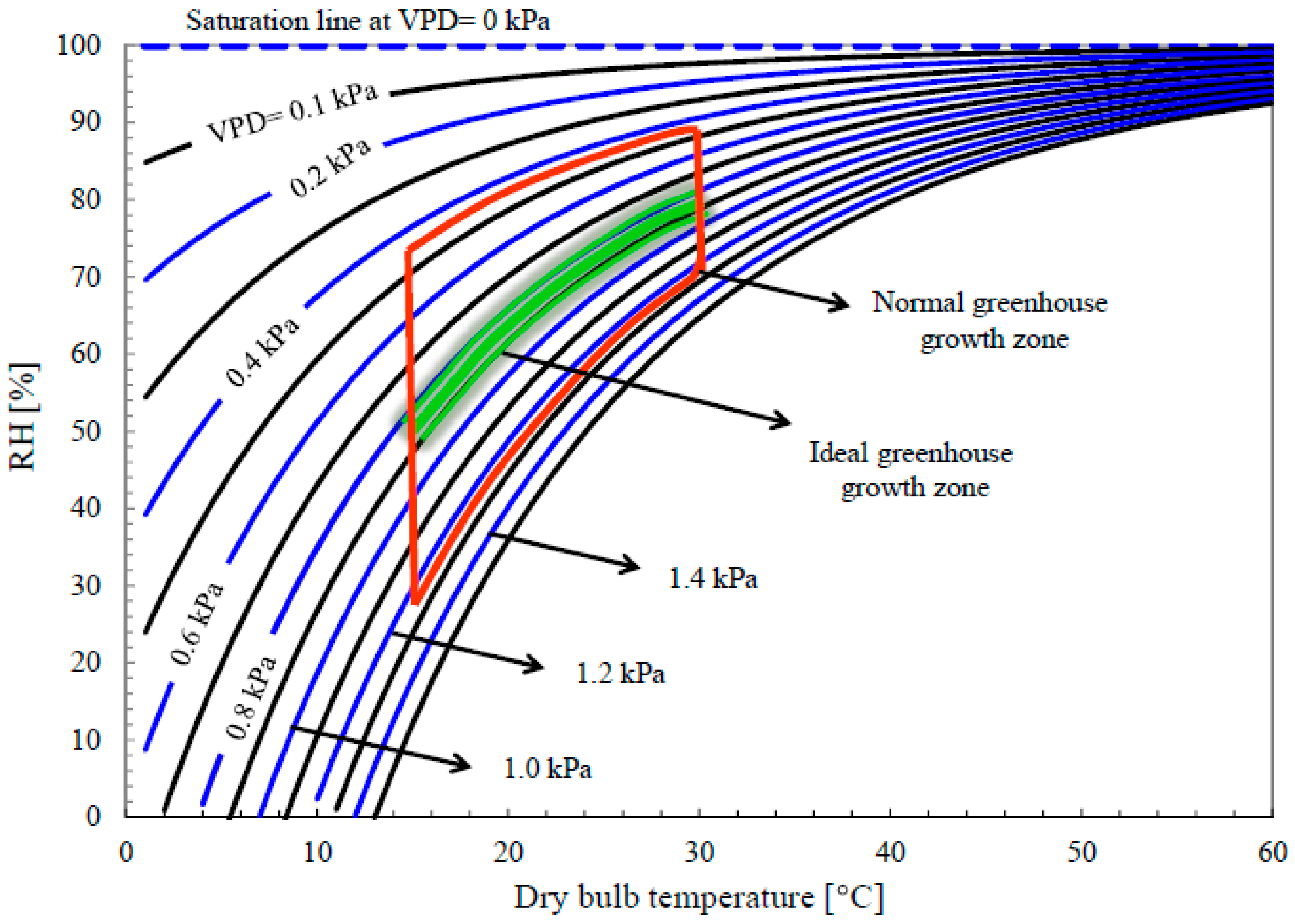


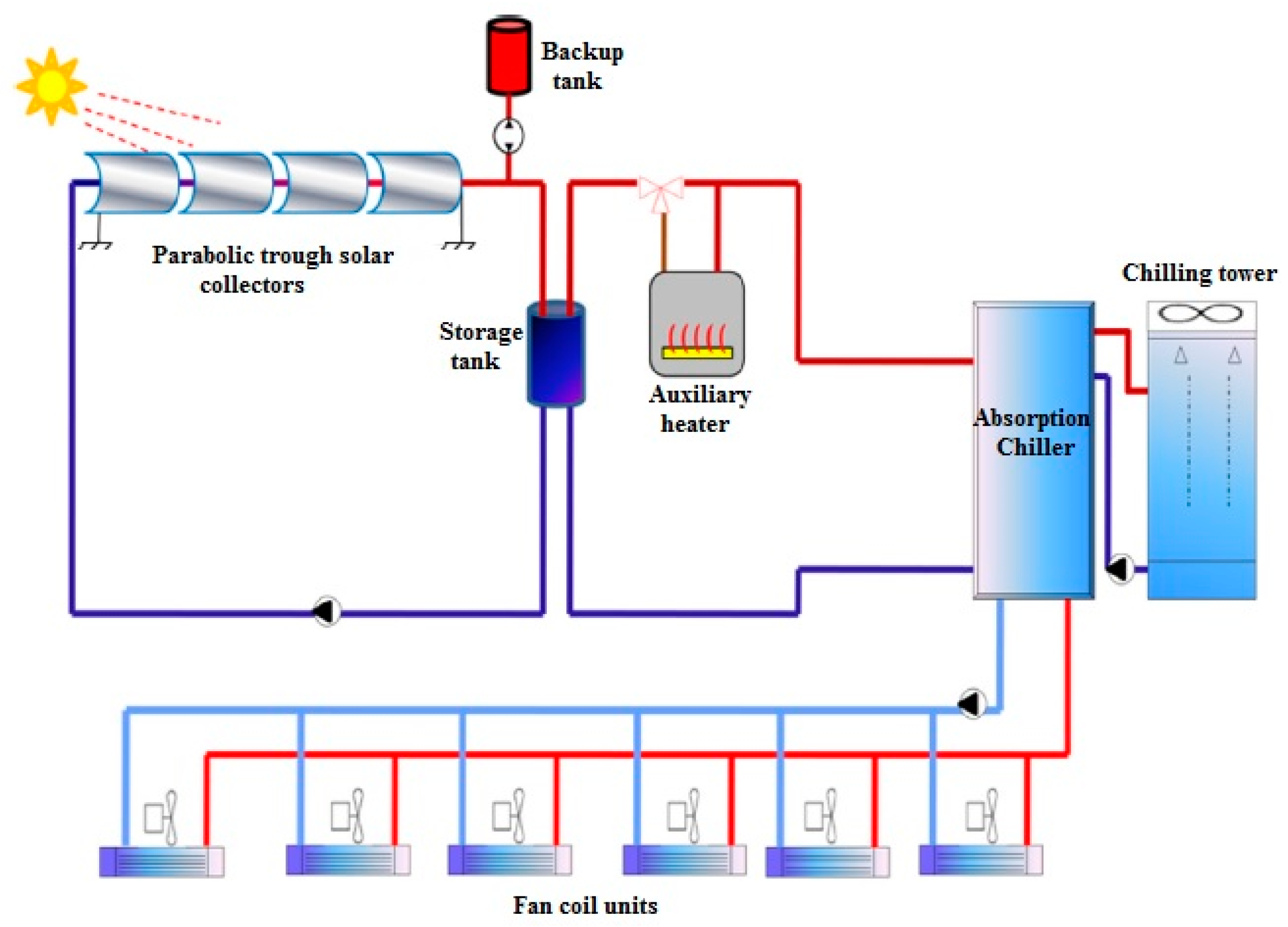
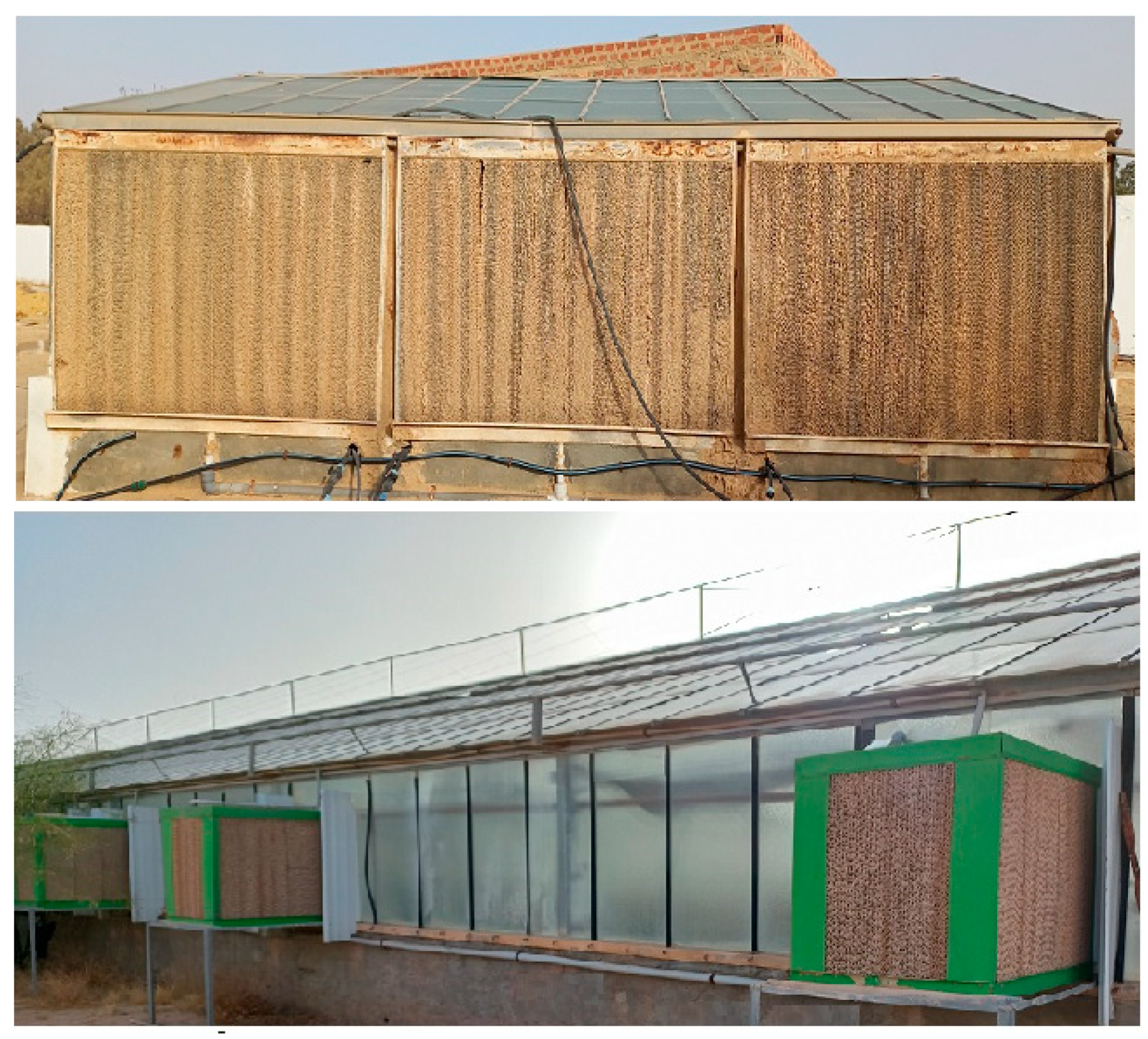
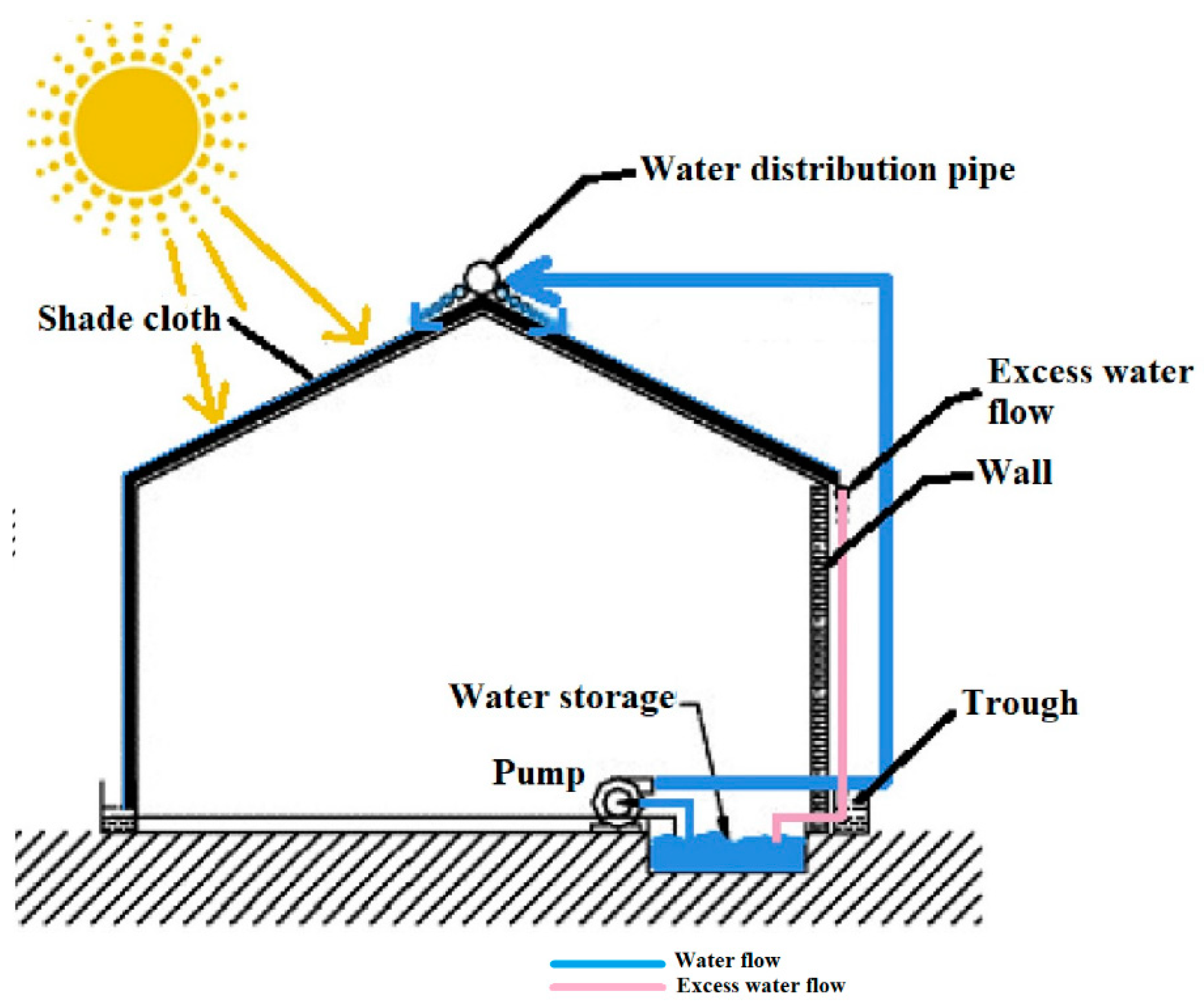

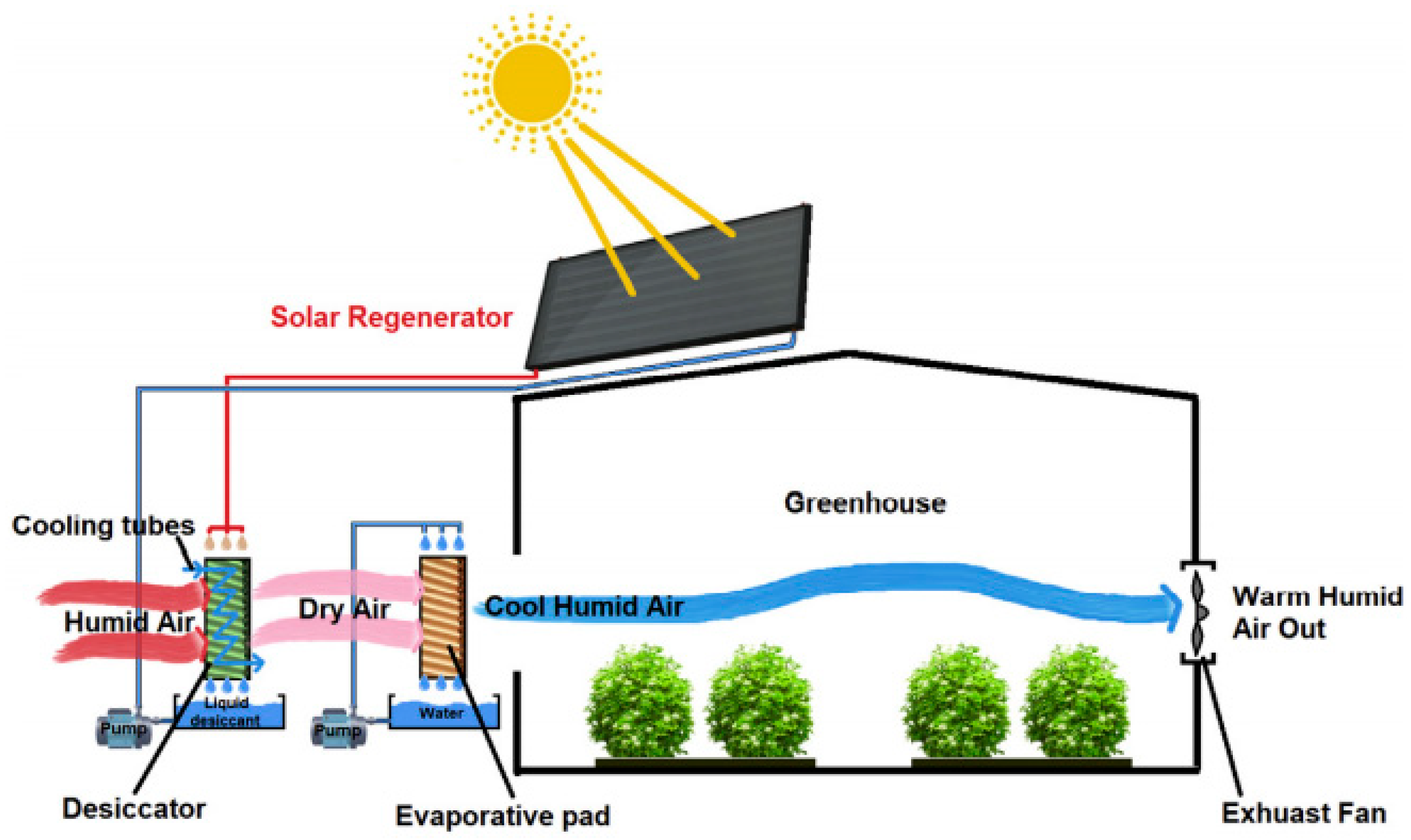
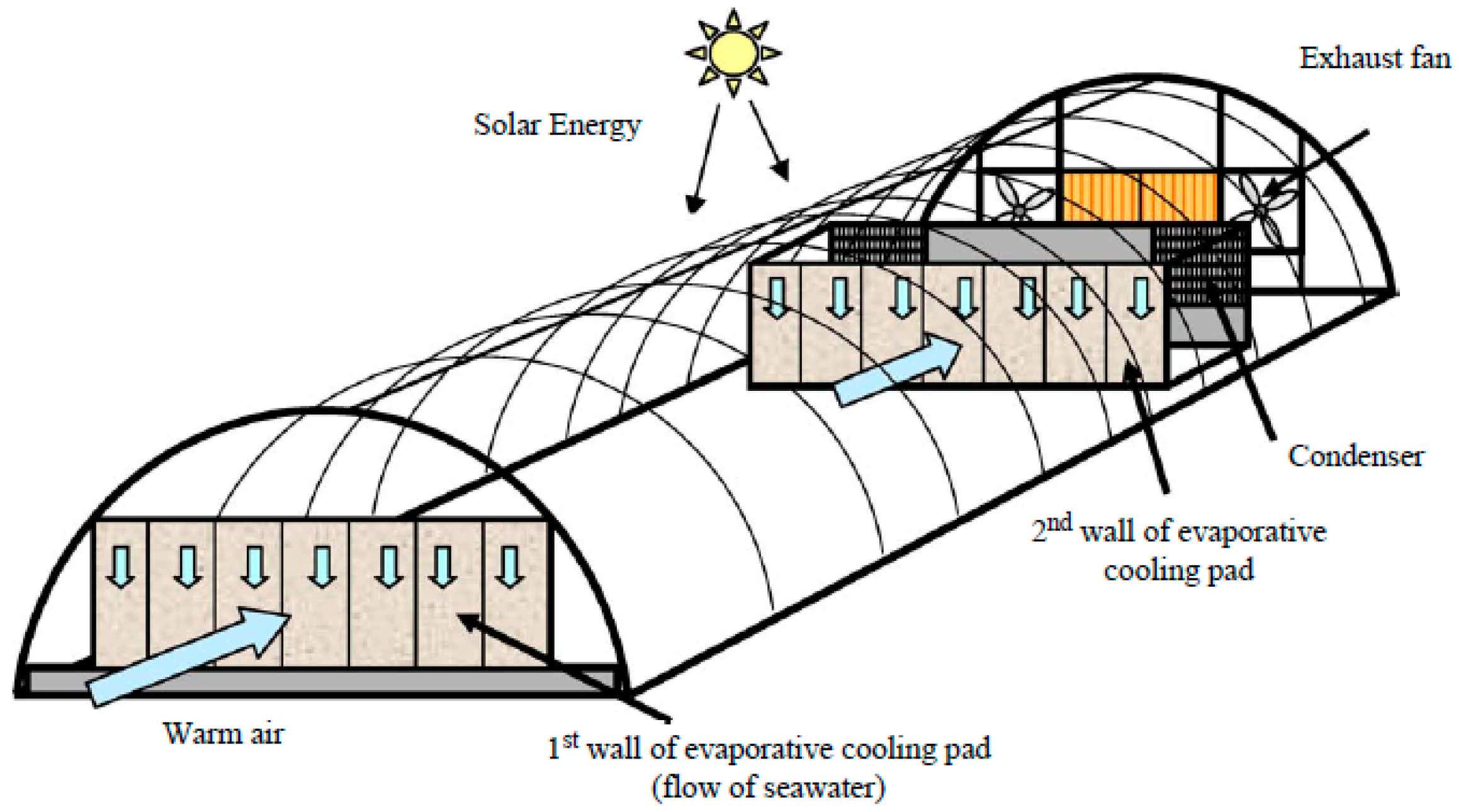


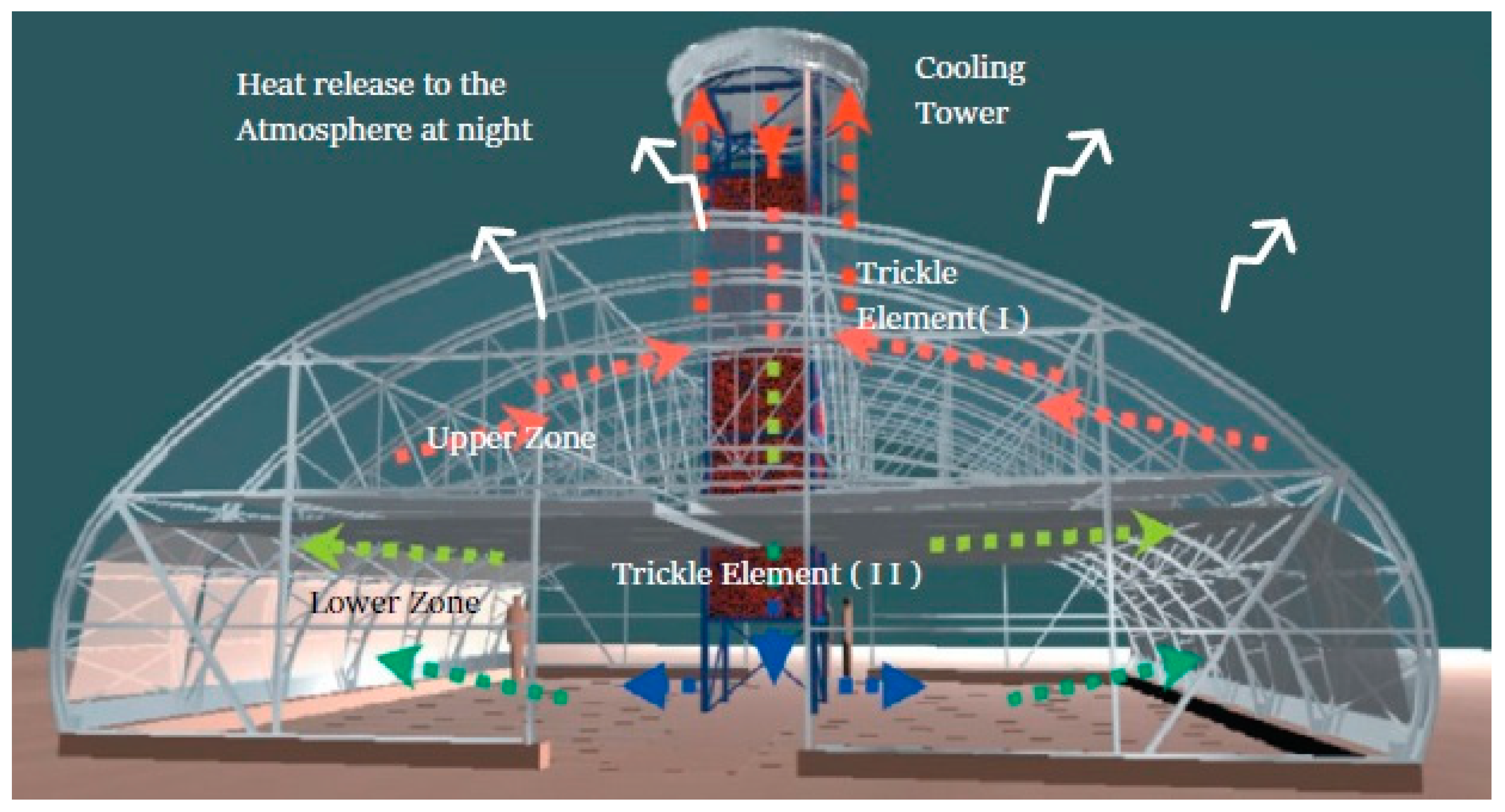
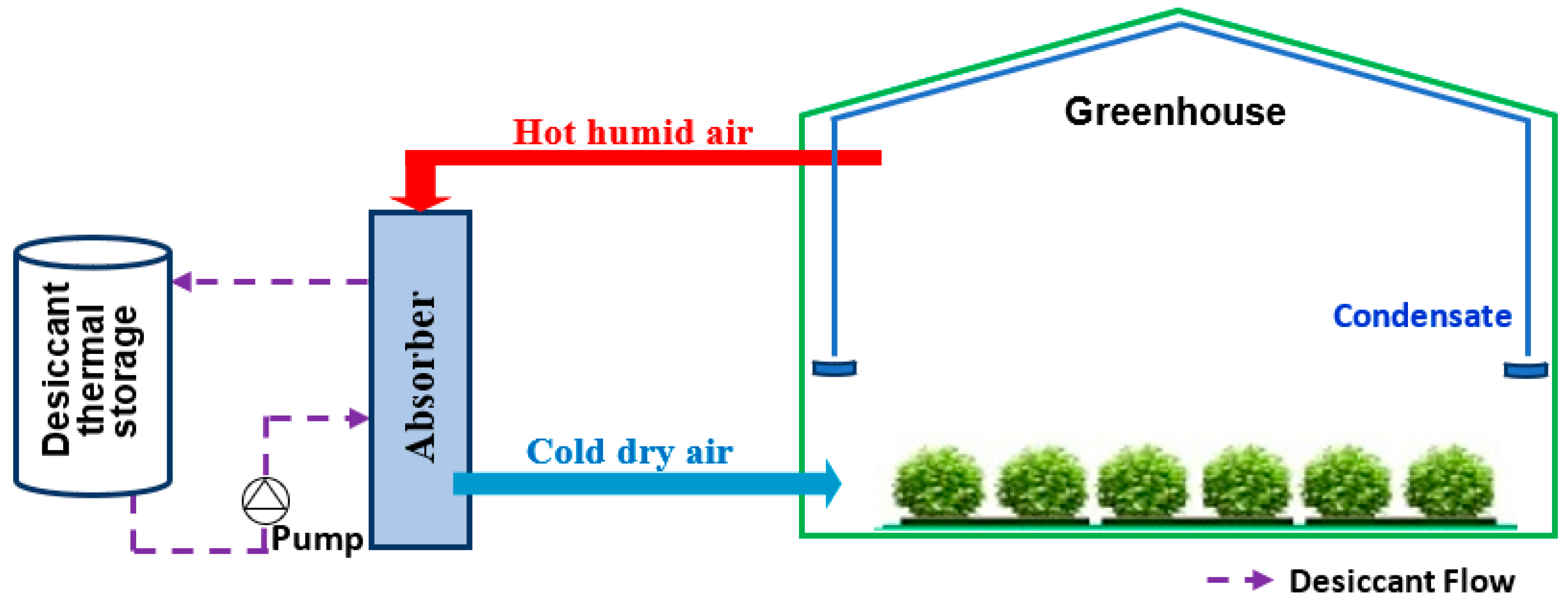
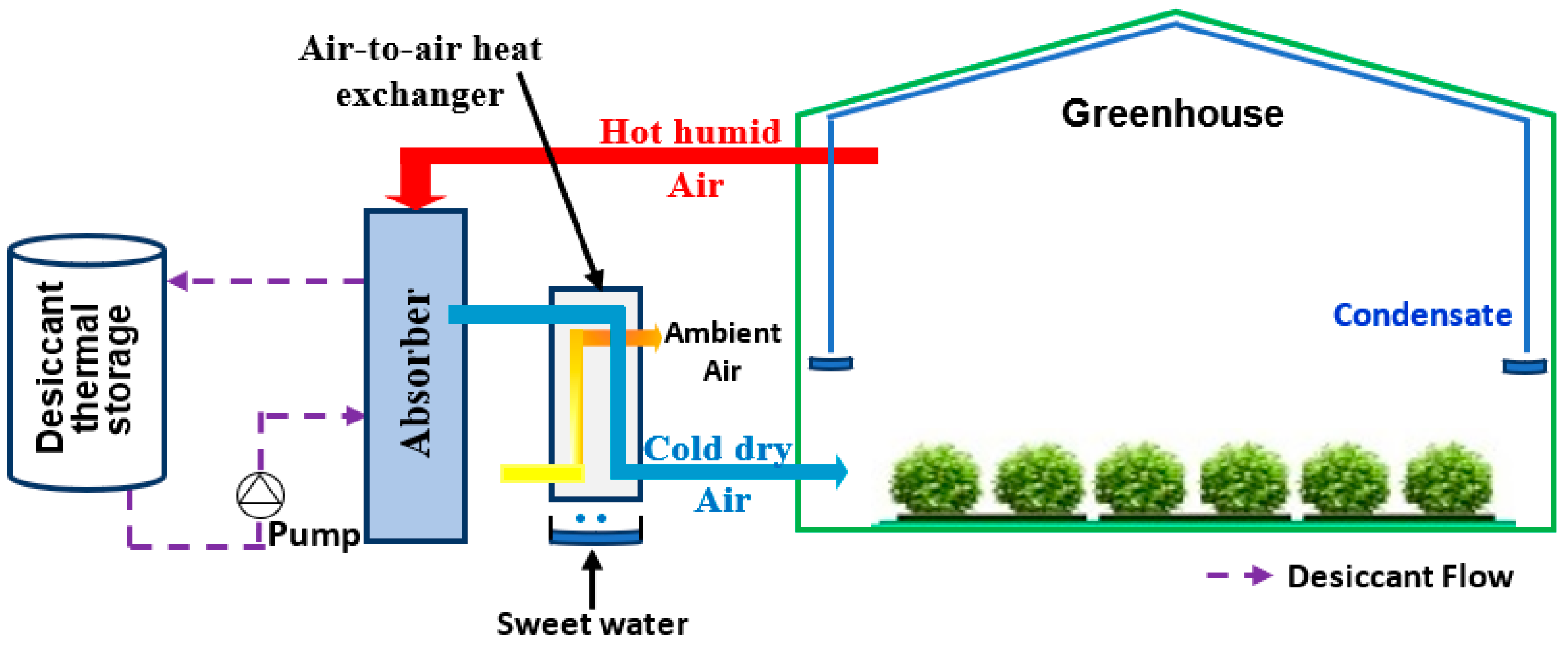
| Optimal T (°C) | Optimal RH (%) | Optimal DLI | Reference | ||
|---|---|---|---|---|---|
| Day | Night | (mol m−2 d−1) | |||
| Tomato | 23–27 | 13–16 | 50–80 | 15–53 | [14,15,16,17] |
| Pepper | 22–30 | 14–16 | 50–70 | 20–30 | [18,19,20,21] |
| Cucumber | 25–30 | 16–18 | 70–90 | 20–53 | [17,19,21] |
| Lettuce | 24–28 | 13–16 | 60–80 | 16–40 | [17,21,22] |
| Aubergine | 25–28 | 14–16 | 50–60 | 40–55 | [17,18,19,21,23] |
| Cabbage | 15–16 | 2 | 70–80 | 42 | [21,24] |
| Courgettes | 20–22 | 17–18 | 65–80 | NA | [19] |
| Beans | 22–26 | 16–18 | 70–80 | 19–24 | [19] |
| Peas | 25–30 | 16–18 | 70–80 | 42 | [21] |
| Strawberry | 20–26 | 13–16 | 50–65 | 17–20 | [25,26,27] |
| Melon | 32 | 14–20 | 65–75 | 58–64 | [17,21,28,29] |
| Types | Locations | Advantages | Limitation | Performance |
|---|---|---|---|---|
| Indirect–direct evaporative cooling (IDEC) unit using groundwater | Baghdad, Iraq [60] | Water saving | Dependent on the groundwater availability | Higher cooling efficiency as compared to the direct evaporative cooler |
| Fan and pad evaporative cooling system | Khartoum, Sudan [92] | Low energy consumption | Short life cycle of the pads | Cooling efficiency up to 90% |
| Fan and pad systems | Shanghai [93] | Energy saving and easily adjustable | Not sufficient in humid climates, and it is necessary to add shading | Decrease in temperature to 27–29 °C |
| Fan and pad systems | Oman [94] | Energy saving and fresh water production | Decrease in water temperature of 3 °C, and increase in the RH to 100% |
| Locations | System Characteristics | Desiccant | Greenhouse Area (m2) | Performance |
|---|---|---|---|---|
| Saudi Arabia [121] | Solar-assisted desiccant-evaporative system; liquid desiccant. | Liquid desiccant nanofluids | 300 | A decrease of 6 °C of the maximum indoor temperature compared to a conventional evaporative cooler. The energy effectiveness reaches 50.10%. |
| The Gulf, Abu Dhabi [3] | Solar regeneration desiccant-evaporative system. | Liquid desiccant, CaCl2 LiCl | 250 | A decrease of 5 °C of the maximum indoor temperature; increase in crop yield; extension of the growing season. |
| Australia [123] | Solar-assisted desiccant system. | Liquid desiccant | - | Good agreement between experimental and numerical results; satisfactory performance. |
| India, Bangladesh, Italy Cuba [124] | Solar-powered desiccant system. | Liquid desiccant, MgCl2 | 1000 | A reduction of 5.5–7.5 °C of the indoor temperature; extension of the growing season. |
| Netherlands [125] | Desiccant system. | Liquid desiccant, CaCl2 LiCl | 40 | RH is maintained between 75% and 85%. |
| India [120] | Solar-powered desiccant evaporative system. | Liquid desiccant, LiCl | 224 | Indoor temperature is maintained below 27 °C; optimum growing conditions for crops. |
| Greece [126] | Hybrid system: air–air heat pump and desiccant | Liquid desiccant, CaCl2 | 63 | RH is maintained below 80%; increase in total water losses. |
Publisher’s Note: MDPI stays neutral with regard to jurisdictional claims in published maps and institutional affiliations. |
© 2022 by the authors. Licensee MDPI, Basel, Switzerland. This article is an open access article distributed under the terms and conditions of the Creative Commons Attribution (CC BY) license (https://creativecommons.org/licenses/by/4.0/).
Share and Cite
Soussi, M.; Chaibi, M.T.; Buchholz, M.; Saghrouni, Z. Comprehensive Review on Climate Control and Cooling Systems in Greenhouses under Hot and Arid Conditions. Agronomy 2022, 12, 626. https://doi.org/10.3390/agronomy12030626
Soussi M, Chaibi MT, Buchholz M, Saghrouni Z. Comprehensive Review on Climate Control and Cooling Systems in Greenhouses under Hot and Arid Conditions. Agronomy. 2022; 12(3):626. https://doi.org/10.3390/agronomy12030626
Chicago/Turabian StyleSoussi, Meriem, Mohamed Thameur Chaibi, Martin Buchholz, and Zahia Saghrouni. 2022. "Comprehensive Review on Climate Control and Cooling Systems in Greenhouses under Hot and Arid Conditions" Agronomy 12, no. 3: 626. https://doi.org/10.3390/agronomy12030626
APA StyleSoussi, M., Chaibi, M. T., Buchholz, M., & Saghrouni, Z. (2022). Comprehensive Review on Climate Control and Cooling Systems in Greenhouses under Hot and Arid Conditions. Agronomy, 12(3), 626. https://doi.org/10.3390/agronomy12030626






